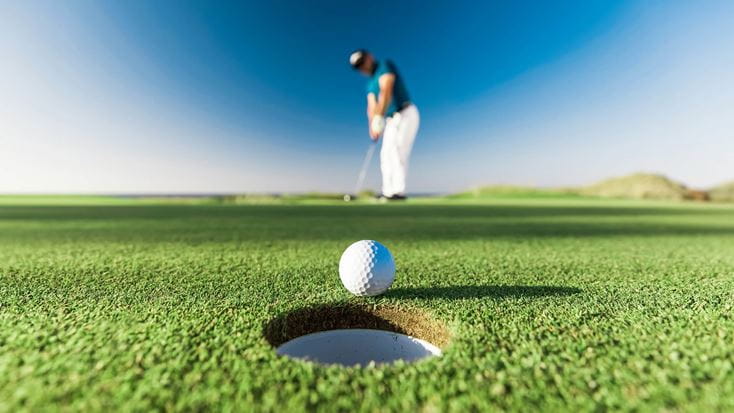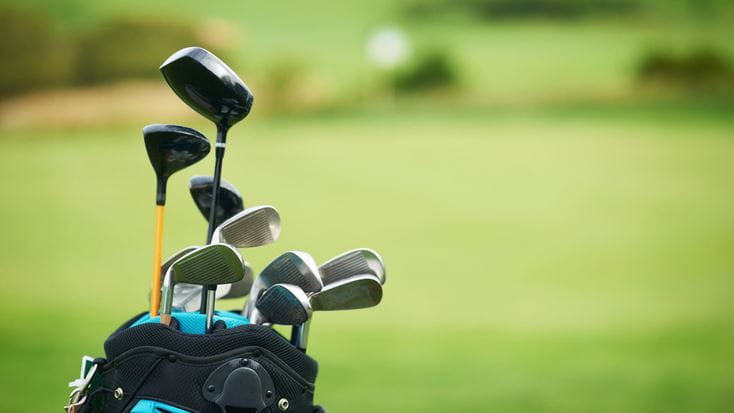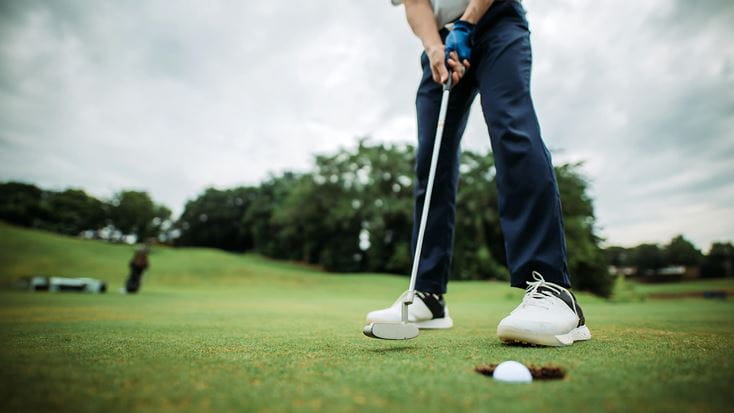Beginner's Guide to Golf

Article
Beginner's Guide to Golf
Everything you need to know about golf
Golf is more than just a game; it’s a rich tradition steeped in history, etiquette and skill. Whether you’re a seasoned player or a curious beginner, understanding the nuances of golf can enhance your experience on the course. If you are just starting out, this comprehensive guide will provide you with all the essential information to get you started on the green.
Read on to find out how to participate in our Tee-off Trivia and stand to win an exclusive Link’s Malls travel bag.

The origins of golf can be traced back to the 15th century in Scotland. The game was initially played on sand dunes and links land, using a stick and a small ball. Over time, golf evolved and spread to other parts of the world, gaining popularity as a recreational and competitive sport.
In 1958, Hong Kong Golf Club member Kim Hall wrote to Australian professional Eric Cremin to see if those players playing in the Open in 1959 would consider staying in the region to play in Hong Kong. He then managed to secure AUD $1,000 in prize money.
Thereafter, the Hong Kong Open, one of Asia's premier golf tournaments, was first held in 1959, making it one of the oldest golf events in the region.
Initially established as a way to promote the sport in Hong Kong, the tournament has since attracted top golfers from around the globe. Over the years, it has been part of various tours, including the European Tour and the Asian Tour, and has become a highlight of the golfing calendar, showcasing the stunning landscapes of Hong Kong.
As a Hong Kong headquartered company, Link Asset Management Limited (Link) is proud to be the title sponsor for Hong Kong Open 2024 with the goal of making golf more accessible to local communities. Keen to catch the tournament? It’s happening from 21 to 24 November 2024 at the Hong Kong Golf Club course in Fanling.

Understanding the various types of golf clubs and the different parts of the course is crucial for any golfer.
Golf Clubs
Golf clubs are essential tools for players, each designed for specific purposes. Here are the main types:
- Driver: The big club. Used to hit the ball off the tee and drive it as far as possible.
- Woods: Lighter and no longer made of wood these days. Typically used for longer shots.
- Irons: Heavier than woods and have a higher loft (the part of the club that touches the ball is angled more). Typically used for shorter shots.
- Wedges: High loft. Primarily used when the ball is close to the hole or needs to be lofted over obstacles.
- Putter: Short club used on the green to gently roll the ball into the hole.
Parts of the Course
A standard golf course consists of several key areas:
- Tee: The starting point of each hole.
- Fairway: The mowed area between the teeing ground and the green. The ideal path for a golf shot.
- Rough: Grass is long and thick. Avoid at all cost.
- Green: The smooth, manicured area around the hole. This is where you putt.
- Hazards: Obstacles that can interfere with a shot include water bodies, bushes and trees.
Basic Equipment of Golf
In addition to golf clubs, there are a few other essential pieces of equipment that you'll need:
- Golf balls: The object of the game is to hit the ball into the hole.
- Golf bag: Used to carry your clubs and other equipment.
- Golf shoes: Designed for traction and stability on the course.
- Golf gloves: Worn on your dominant hand to improve your grip.
- Golf tees: Used to elevate the ball off the tee.

Gripping the golf club correctly is fundamental to achieving consistent shots and improving your overall game. While there are several types of grips, one of the most popular among beginners is the overlapping grip. Here’s a step-by-step guide to mastering it:
- Positioning Your Hands
- Left Hand First: Start by placing your left hand on the grip (for right-handed golfers). Your thumb should run down the shaft, and the fingers should wrap around it comfortably.
- Grip Pressure: Hold the club firmly but not too tightly. A relaxed grip allows for better clubhead speed and control.
- Overlapping with the Right Hand
- Right Hand Placement: Next, bring your right hand to the club. Place the fingers of your right hand on the grip so that the pinky finger overlaps the index finger of your left hand. This creates a more unified grip and enhances control.
- Thumb Position: The right thumb should rest comfortably against the grip, slightly to the side, ensuring it does not interfere with the swing motion.
- Check Your Alignment
- V Shape: When you look down at your hands on the grip, both thumbs should form a "V" shape pointing towards your right shoulder (for right-handed golfers). This alignment helps ensure proper hand positioning during your swing.
- Adjust as Needed: If you feel discomfort or lack control, adjust the position of your hands slightly until it feels more comfortable and natural.
- Practise Your Grip
- Repetition: Like any skill in golf, practice is key. Spend time gripping the club while practising your stance and swing to build muscle memory.
- Feedback: Consider having an experienced golfer or coach check your grip to ensure you’re set up correctly.

A good golf swing is a series of coordinated movements that allow you to strike the ball effectively and consistently. Here are the key components of a successful swing:
- Taking a Backswing
- Setup: Start by positioning yourself correctly with your feet shoulder-width apart, knees slightly bent, and your weight balanced.
- Initiate the Backswing: Rotate your shoulders and hips while keeping your arms relaxed. Your left arm (for right-handed golfers) should remain straight but not rigid.
- Club Position: As you turn your body, the club should move back smoothly, keeping the clubhead low to the ground initially. Aim to create a "L" shape with your left arm and the club at the top of the backswing.
- Striking the Ball with the Clubface
- Transition: As you complete your backswing, shift your weight to your front foot and initiate the downswing. This motion should feel like a natural transition rather than a forced movement.
- Swing Path: Aim for an inside-out swing path, where the clubhead approaches the ball from the inside, allowing for a more powerful and accurate strike.
- Impact: Focus on hitting the ball with the clubface squarely at impact. This is crucial for achieving distance and accuracy. Your body should be aligned towards your target, with your eyes fixed on the ball.
- Following Through
- Continue the Motion: After striking the ball, allow your swing to follow through naturally. Your arms should extend fully towards your target, and your body should rotate towards the hole.
- Balance: A good follow-through demonstrates proper weight transfer and balance. Ideally, you should finish with your weight on your front foot, your chest facing the target, and your club resting behind you.
- Observe Your Finish: A balanced finish is an indicator of a well-executed swing. Take a moment to appreciate your position at the end of the swing, as it reflects your overall technique.
Common Golf Terms You Need to Know
Whether you’re discussing your last round with friends or following a tournament on TV, familiarity with common golf terms will enhance your experience and make you feel more at home on the greens.
- Barkie: Hitting a tree and still making a par.
- Birdie: A score of one stroke under par on any hole.
- Bogey: A score of one stroke over par on any hole.
- Breakfast ball: An unofficial rule of golf that gives you a free mulligan on the first tee. For many golfers, it’s the most important meal of the day.
- Fore!: A warning shout used to alert other golfers when a ball might be heading their way.
- Mulligan: An informal do-over, allowing a player to hit a second shot after a bad first attempt.
- Slice: A shot that curves to the right.
- Hook: A shot that curves to the left.

Attending a golf tournament can be an exhilarating experience, but it also comes with a unique set of etiquette guidelines to ensure that players and fellow spectators enjoy the event. Here are some detailed points to keep in mind when you're on the course:
1. Maintain Silence
One of the most important aspects of golf etiquette is the need for silence during a player’s swing. Unlike many sports, golf requires intense concentration, and any noise can disrupt a player’s focus.
Refrain from conversations while a player is preparing to take their shot. Wait until after they’ve hit the ball to speak. Ensure your mobile device is on silent mode or turned off to avoid distractions. Need to take a phone call? Head to the clubhouse.
2. Stay Still
Movement can be distracting for players. Keep your movements to a minimum while players are taking their shots. If you need to adjust your position, do so quietly and without drawing attention to yourself. Wait for a natural break in play to move.
3. Respect the Course and Surroundings
The game takes place on a delicate surface that must not be disturbed by metal cleats or heels. Wear flat-soled shoes and avoid walking on the greens and tees unless you are in designated areas, as this can damage the course.
4. Dress Appropriately
Golf tournaments often have dress codes, reflecting the sport’s tradition. Many courses prefer attendees to wear collared shirts and dress pants or shorts. Check the event’s dress code before attending.
Instead of bringing an umbrella, which can obstruct views for others, opt for a visor or a wide-brimmed hat to shield yourself from the sun while allowing for unobstructed viewing.
WIN a Link's Malls foldable travel bag!
As you step onto the course, remember that golf is more than just a competition; it's a journey of joy, camaraderie, and personal growth. Embrace the learning process, practice regularly and savour the beauty of each round.
To help you kickstart your golfing experience and loosen your muscles, OSIM is offering up to 50% OFF selected massagers to members only. Get the uCozy 3D Neck & Shoulder Massager at just $99 (U.P. $199) or the uGun X-Sports Percussive Massage Gun at just $219 (U.P. $399). Redeem the coupon on the L Privileges app today!
Grab your clubs, hit the greens and enjoy every moment of your golfing adventure!
Want to win yourself a Link’s Malls foldable travel bag? Simply submit your answers to the questions below. Look out for new questions released every Thursday at 10am from now till 13 November 2024.


 Download L Privileges app
Download L Privileges app










